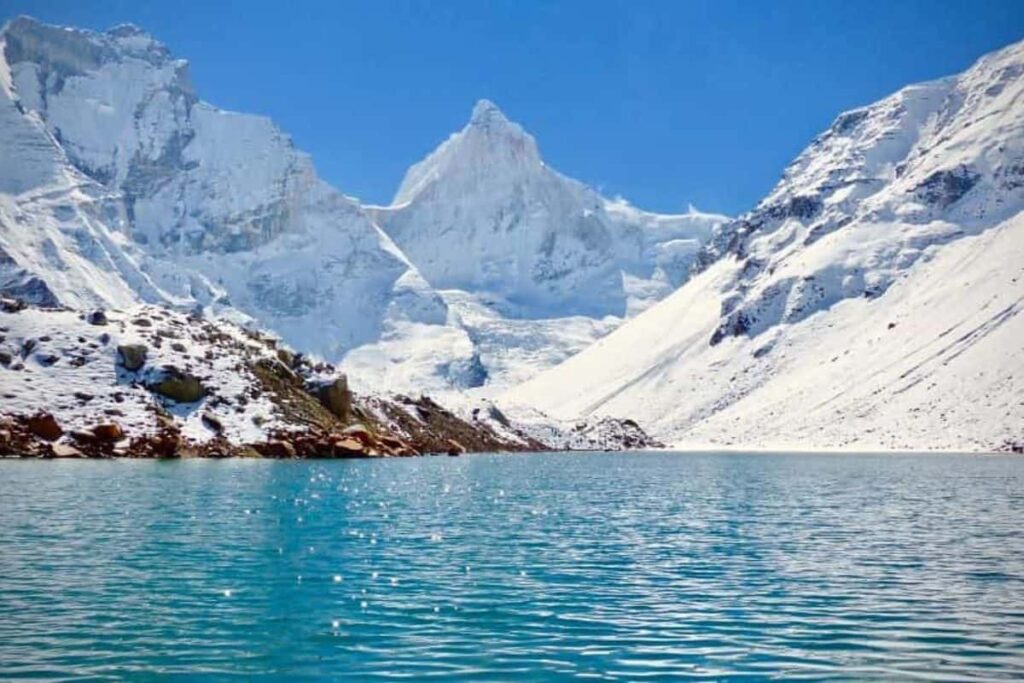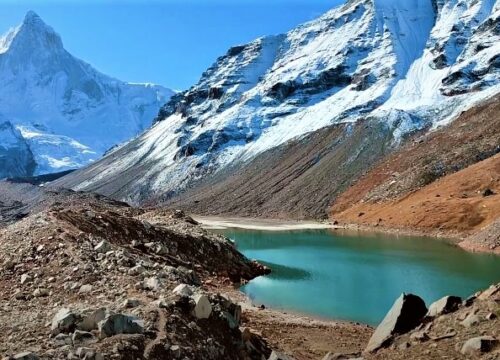Kedartal Trek the Ultimate Lake of Lord Shiva
- Home
- Kedartal Trek the Ultimate Lake of Lord Shiva
Kedartal Trek the Ultimate Lake of Lord Shiva
Trek Location
Duration
Explore Tours
Why Kedartal Trek Should Be on Your Bucket List?
In the Garhwal Himalayas of Uttarakhand, India, at an altitude of 15,500 feet (4,724m), Kedartal, often revered as “Shiva’s Lake,” is more than a trek. It’s a pilgrimage and adventure with nature’s grandeur; it’s a high-altitude glacial lake with towering peaks like Thalaysagar, Bhirupanth and Meru Glacier. Here’s why Kedartal deserves a top spot on trekkers’ bucket lists, backed by facts, insights and the reason why trekkers, spiritual seekers and nature lovers are drawn to this Himalayan gem.
Kedartal is deeply tied to Hindu mythology. The lake is to be a meditation spot of Lord Shiva, and its waters feed the Kedar Ganga, Which joins the Bhagirathi (a headstream of the Ganga) at Gangotri. This Kedartal trek lies within Gangotri National Park, a 2,390 sq. km. reserve home to rare species like the Himalayan Blue Sheep (Bharal), Snow Leopard, Himalayan Black Bear and Musk Deer. The trail passes through Bhojpatra forests (Himalayan Birch, used in ancient manuscripts) and alpine meadows blooming Brahma Kamal (Uttarakhand’s state flower) in September-October.
Kedartal is a glacial lake fed by the Kedar Glacier, Formed by the melting snow of Thalaysagar (6,904m) and Bhrigupanth (6,722m) peaks. Its emerald green water is crystal clear and creates a mirror like reflection of the surrounding peaks, especially Thalaysagar, which locals call “Shiva’s Trident” due to its sharp trident-shaped summit. It is a 6 day journey covering approximately 32 Km round trip From Gangotri, with a cumulative elevation gain of over 5,500 feet. Rated moderate to difficult, it involves navigating steep ascents, rocky moraines, a landslide zone, and the famous spider wall, which is an exposed trail above the Kedar Ganga gorge.

Overview of the Kedartal Trek
- Trek Distance – 32 Kilometer (Round trip)
- Altitude – 16,116 ft
- Duration – 6 Days
- Difficulty Level – Moderate to Difficult
- Who Can Attempt – You have follow a 2 weeks of exercise
- Best Season to do Kedartal Trek –
- Located – Gangotri, Uttarkashi, Uttarakhand
Cultural and Spiritual Things about Kedartal Trek
The Kedartal Trek is not only a trekking destination or a journey but also a pilgrimage steeped in cultural, spiritual and mythological importance. The trek’s endpoint, Kedartal Lake, and its starting point, Gangotri, are deeply rooted in Hindu traditions.
Shiva and the Kedar Ganga: According to legend, Kedar Ganga, which originates close to Kedartal, is a stream blessed by Lord Shiva. It is believed that Shiva released the Ganga from his matted locks at Gangotri, and the Kedar Ganga is an extension of this divine flow.
Pandavas: In the Mahabharata, the Pandavas are said to have traveled through the Himalayas in search of spiritual salvation. Local folklore links Kedartal to their journey and says they visited the lake for Shiva’s blessing before going to Swargarohini, the mythical path to heaven. The nearby peak, Thalaysagar, is sometimes associated with their divine encounter.
Kedar and Ancient Rishis: The name “Kedartal” is linked to Sage Kedar, a revered figure in Hindu mythology who is believed to have meditated near the lake. Rishis are said to have performed penance in this region, drawn by its spiritual energy.

Physical Preparation for Kedartal Trek
The Kedartal Trek is a beautiful but challenging adventure in the Himalayas, reaching altitudes up to 4,750 meters (25,580 ft) with rocky terrain, steep ascents and long trekking days. To enjoy the trek safely and comfortably, you need good physical fitness and stamina.
This guide explains the fitness requirements for the Kedartal Trek and provides easy-to-follow pre-trial training to help you prepare.
Fitness Requirements for Kedartal Trek
The Kedartal Trek is rated as moderate to challenging, suitable for experienced trekkers or fit beginners with proper preparation.
- Cardiovascular Endurance: you’ll trek 4-8 Horus daily, covering 5-13 km at high altitudes where oxygen is low. Good heart and lung stamina are essential to keep going without getting too tired.
- Leg Strength: The trail has steep climbs, rocky paths and boulder sections. Strong legs (Quads, hamstrings, calves) help you tackle ascents and descents without strain or cramps.
- Core and Back Strength: Carrying a daypack (5-10kg) and maintaining balance on uneven terrain requires a strong core and back to avoid fatigue or back pain.
- Flexibility: Flexible muscles and joints reduce the risk of injuries, especially on rocky or slippery paths. Stretching helps with recovery after long trekking days.
- Altitude Adaptation: At 4,750 meters, altitude sickness is a risk, so your body needs to be fit enough to handle low oxygen levels and adapt to high altitude conditions.
Who can do this trek?
- People who have done some moderate and tough treks before or with good fitness levels.
- Healthy adults (18-50 years) with no serious medical condition (heart, lung or joint issues).
- Beginners can join if they train for 6-8 weeks and consult a doctor before starting.
FAQs About Kedartal Trek
- Is Kedartal Trek Suitable for Beginners?
- What is the Mobile Network Connectivity Like?
- Are There Medical Facilities Available on the Trek?
- How Safe is the Kedartal Trek for Solo Women Travelers?
- Can Kedartal Trek Be Done in the Monsoon Season?
FAQ
Essential Items You Must Carry
In Clothing
- Base Layers:
- Insulating Layers:
- Trekking Clothes:
- Accessories:
- Footwear:
- Personal Gear
- Toothbrush, toothpaste, biodegradable soap, small towel.
- Lip balm (SPF 30+), sunscreen (SPF 50+), moisturizer.
- Toilet paper, wet wipes, hand sanitizer.
- Menstrual hygiene products (if applicable).
Trek Itinerary
- Duration: 8-10 Hours
- Distance: 250 km
This journey begins from Dehradun, the capital of Uttarakhand, to Gangotri, a holy town and the starting point of the trek. The route passes through Mussoorie, Uttarkashi and some of the small towns and villages, following the Bhagirathi River.
- Duration: 5-6 hours (trek)
- Distance: 8 km
Early in the morning, after breakfast, a packed lunch and a short briefing, we start the trek by ascending along a well-defined trail through pine and birch (Bhojpatra) forests. The path follows the Kedar Ganga River with gradual inclines and occasional rocky patches, as well as wooden bridges. Enjoy the view of snow-capped peaks.
Bhojkharak is known for its birch forests, which have historically been used for writing scriptures. At the campsite, every trekker can enjoy the views of the surrounding peaks and the Kedar Ganga. The pure air of the mountains and the sound of the river makes it a tranquil spot for the first night on the trail.
- Duration: 4–5 hours (trek)
- Distance: 5 km
The Trail from Bhojkharak to Kedarkharak is more challenging, with steeper ascents and rocky terrain. Guides navigate narrow paths along the Kedar Ganga, crossing streams and moraines. The open landscapes reveal dramatic views of Thalaysagar and Birgupanth peaks. Kedarkharak is a grassy meadow with panoramic mountain views, and it's an ideal spot for acclimatization before the push to Kedartal.
- Duration: 7–8 hours (round-trip trek)
- Distance: ~8 km (Round trip)
Day 4 is the most demanding, involving a steep and rocky ascent to Kedartal Lake and a return to Kedarkharak. The trail crosses glacial moraines and boulder-strewn paths with careful navigation or guidance from our Guide. The final stretch reveals the crystal-clear Kedartal Lake, which is also Lord Shiva's lake. After spending 1-2 hours at the lake, all the team and trekkers get back to Kedarkharak campsite.
- Duration: 6–7 hours (trek)
- Distance: 13 km
From Kedarkharak to Gangotri, it retraces the route through Bhojkharak and the trail is mostly downhill, passing through familiar birch forests along the Kedar Ganga.
- Duration: 8–10 hours (drive)
- Distance: ~250 km (by road)
The final day involves a road trip back to Dehradun, retracing the route along the Bhagirathi River through Uttarkashi and Mussoorie. The drive offers one last chance to admire the Himalayan foothills.






